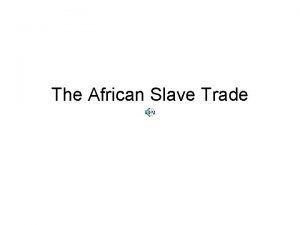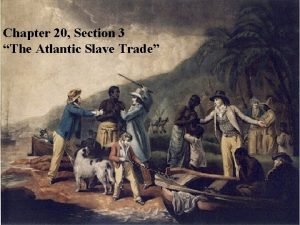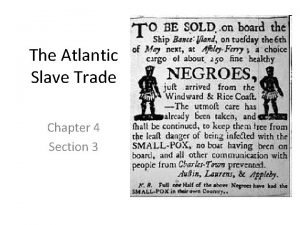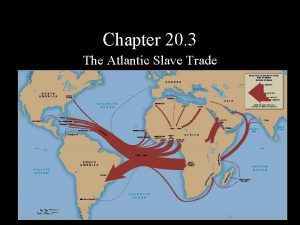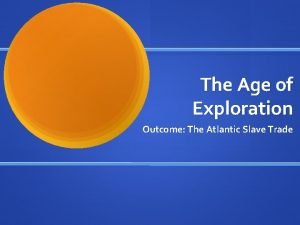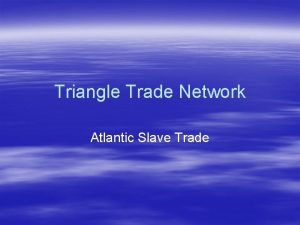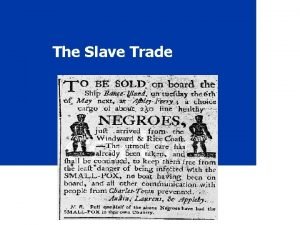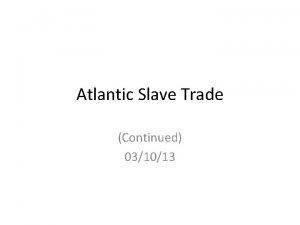THE MIDDLE PASSAGE ATLANTIC SLAVE TRADE In order





- Slides: 5

THE MIDDLE PASSAGE

ATLANTIC SLAVE TRADE ■ In order to establish profitable colonies, European countries needed a large supply of labor. Europeans enslaved indigenous peoples, but because many indigenous populations were decimated by European disease and violence, indigenous slavery didn’t meet the labor demands of the colonies. ■ In the 16 th century, Europeans began purchasing enslaved Africans from West African traders. The forced labor of Africans proved hugely profitable for Europe and its colonies. Slave owners didn’t pay their slaves, and the life-long and hereditary nature of slavery guaranteed new generations of free labor. In order to maximize profits for slave owners, working conditions for slaves in the colonies were often atrocious.

ATLANTIC SLAVE TRADE ■ Over the course of the next four centuries, it is estimated that more than 12. 5 million Africans were taken from Africa. Due to the brutal conditions on the trip to the Americas, historians estimate that only 10. 7 million of the captives survived. The vast majority of those slaves were taken to European colonies in South America and the Caribbean. The most recent estimates suggest that less than 400, 000 slaves were taken directly from Africa to the present-day United States. The Portuguese, British, French, Spanish, and Dutch were the main slave traders. ■ The slave trade drastically changed African societies. In the centuries before the Atlantic slave trade, mutually beneficial intercontinental trade was an important part of African states’ economies. Many of these relationships were replaced by the slave trade. In Africa, the slave trade destabilized states, created economic depressions, and led to wars.

MIDDLE PASSAGE ■ The Atlantic slave trade was part of a broader economic system known as the Triangular Trade that connected three continents. European traders would transport enslaved Africans to European colonies in the Americas, where the slaves would work to produce various agricultural goods, including sugar, cotton, and tobacco. Those raw goods were then shipped back to Europe in order to be turned into manufactured goods. ■ European traders would subsequently trade those goods with West African slave traders for more kidnapped Africans, and the cycle would continue. It is important to note that there were also various exceptions to this basic outline. ■ For instance, European manufactured goods were also sold to colonies in the Americas. ■ Similarly, sugar produced in the Caribbean was sold in New England rum produced in the Americas was sold in Africa.

CRITICAL HISTORICAL QUESTION ■ Although it is important to consider the economic system that facilitated the Atlantic slave trade, the sheer scale of the trade can obscure the experiences of individuals. We don’t want to lose track of the individuals involved in the Middle Passage, so we’re going to read a series of documents to answer this question: How did people experience the Middle Passage?
